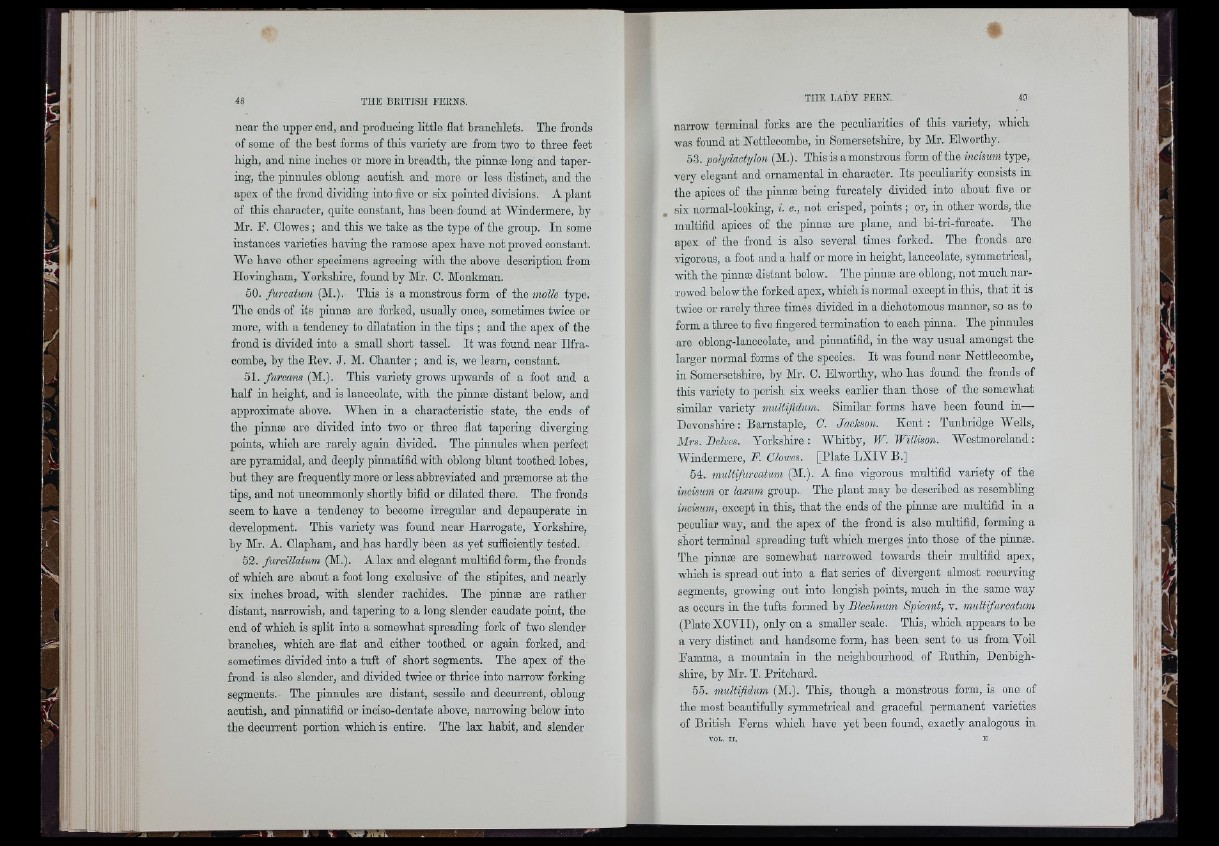
near the upper end, and producing little flat branchlets. The fronds
of some of the best forms of this variety are from two to three feet
high, and nine inches or more in breadth, the pinnæ long and tapering,
the pinnules oblong acutish and more or less distinct, and the
apex of the frond dividing into five or six pointed divisions. A plant
of this character, quite constant, has been found at Windermere, by
Mr. F. Clowes ; and this we take as the type of the group. In some
instances varieties having the ramose apex have not proved constant.
We have other specimens agreeing with the above description from
Ilovingham, Yorkshire, found by Mr. 0. Monkman.
50. furcatum (M.). This is a monstrous form of the molle type.
The ends of its pinnæ are forked, usually once, sometimes twice or
more, with a tendency to dilatation in the tips ; and the apex of the
frond is divided into a smaU short tassel. It was found near Ilfracombe,
by the Eev. J. M. Chanter ; and is, we leam, constant.
61. fiircans (M.). This variety grows upwards of a foot and a
half in height, and is lanceolate, with the pinnæ distant below, and
approximate above. When in a characteristic state, the ends of
the pinnæ are divided into two or three flat tapering diverging
points, which are rarely again divided. The pinnules when perfect
are pyramidal, and deeply pinnatifid with oblong blunt toothed lobes,
but they are frequently more or less abbreviated and præmorse at the
tips, and not uncommonly shortly bifid or dilated there. The fronds
seem to have a tendency to become irregular and depauperate in
development. This variety was found near Harrogate, Yorkshire,
by Mr. A. Clapham, and has hardly been as yet sufiioiently tested.
52. furcillatum (M.). A lax and elegant multifid form, the fronds
of which are about a foot long exclusive of tbe stipites, and nearly
six inches broad, with slender rachides. The pinnæ are rather
distant, narrowish, and tapering to a long slender caudate point, the
end of which is split into a somewhat spreading fork of two slender
branches, which are flat and either toothed or again forked, and
sometimes divided into a tuft of short segments. The apex of the
frond is also slender, and divided twice or thrice into narrow forking
segments. The pinnules are distant, sessile and decurrent, oblong
aoutish, and pinnatifid or inoiso-dentate above, narrowing below into
the decurrent portion which is entire. The lax habit, and slender
narrow terminal forks are the peculiarities of this variety, which
was found at Nettlecombe, in Somersetshire, by Mr. Elworthy.
63. polydactylon (M.). This is a monstrous form of the incisum type,
very elegant and ornamental in character. Its peculiarity consists iu
the apices of the pinnæ being furcately divided into about five or
six normal-looking, i. e., not crisped, points ; or, in other words, the
multifid apices of the pinnæ are plane, and bi-tri-furoate. The
apex of the frond is also several times forked. The fronds are
vigorous, a foot and a half or more in height, lanceolate, symmetrical,
with the pinnæ distant below. The pinnæ are oblong, not much narrowed
below tbe forked apex, which is normal except in this, that it is
twice or rarely three times divided in a diohotomous manner, so as to
form a three to five fingered termination to each pinna. The pinnules
are oblong-lanceolate, and pinnatifid, in the way usual amongst the
larger normal forms of the species. It was found near Nettlecombe,
in Somersetshire, by Mr. C. Elworthy, who has found the fronds of
this variety to perish six weeks earUer than those of the somewhat
similar variety multifidum. Similar forms have been found in—
Devonshire : Barnstaple, C. Jackson. Kent: Tunbridge Wells,
Mrs. JDelves. Yorkshire: ^yhiü¡y, W. Willison. Westmoreland:
Windermere, F. Clowes. [Plate LXIV B.]
54. multifurcatum (M.). A fine vigorous multifid variety of the
incisum or laxum group. The plant may be described as resembling
incisum, except in this, that the ends of the pinnæ are multifid in a
peculiar way, and the apex of the frond is also multifid, forming a
short terminal spreading tuft which merges into those of the pinnæ.
The pinnæ are somewhat narrowed towards their multifid apex,
which is spread out into a flat series of divergent almost recurving
segments, growing out into longish points, much in the same way
as occurs in the tufts formed by Blechnum Spicant, v. multifurcatum
(Plate XCVII), only on a smaller scale. This, which appears to be
a very distinct and handsome form, has been sent to us from Yoil
Eamma, a mountain in the neighbourhood of Euthin, Denbighshire,
by Mr. T. Pritchard.
55. multifidum (M.). Tbis, though a monstrous form, is one of
the most beautifully symmetrical and graceful permanent varieties
of British Ferns which have yet been found, exactly analogous in
I
■ r
; 1*1
I